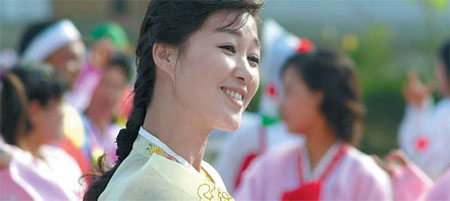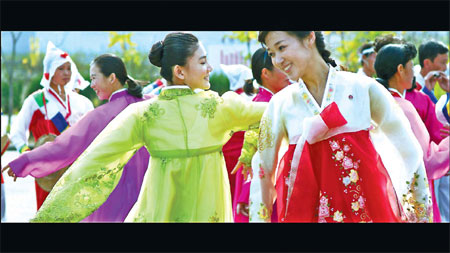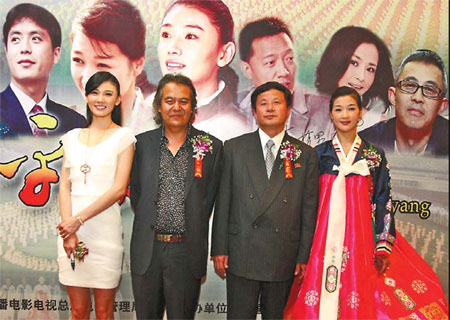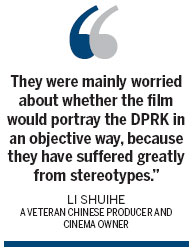Movie focuses on true spirit of partnership, reports Liu Wei in Beijing.
Given the long-standing friendship between China and the Democratic People's Republic of Korea, it's an odd fact that Meet in Pyongyang is the first movie collaboration between the two countries.
The movie project was not initiated by politicians, but by Li Shuihe, a veteran Chinese producer and cinema owner.
Li, 65, a former head of the Shanxi Film Studio, has vast experience with the DPRK and in 2006 brought a film called Warm Spring to the Pyongyang International Film Festival, scooping one of the top awards.
 |
|
A scene from Meet in Pyongyang, the first movie collaboration between China and the DPRK. Provided to China Daily |
Along with two other Shanxi studio productions, Warm Spring later went into general release in the country's movie theaters.
In the course of his nine visits to the DPRK, Li built up close relationships with filmmakers and officials, leading Kim Ung-gol, director of the co-production department at the DPRK Film Import and Export Company, to describe him as a "trusted friend".
Co-producing a movie with the DPRK seemed a natural course of action for Li, who wanted to make "a film that shows how the country looks and depicts the real lives of its people. A film that would be eye-catching".
In 2009, on the 60th anniversary of the establishment of diplomatic relations between the two countries, Li raised the idea with officials from the DPRK film industry, who readily accepted. A budget of 16 million yuan($2.5 million) was agreed.
A guiding principle was quickly adopted: Both sides would collaborate on the script. But even with that simple agreement, it took two years to find a storyline that satisfied both.
The parties found it easy to agree on an overall theme - that of the friendship between the two countries - but illustrating that idea led to prolonged discussions.
On the Chinese side, Xierzhati Yahefu, a member of the Uygur ethnic group, was chosen as director because of his great experience of scenic shooting. He was told that the filmmakers would have a free hand, apart from one crucial stipulation: The film had to do well at the box office.
Drafting the story
The first draft revolved around how the peoples of the two countries united to fight the Japanese in World War II. However, the idea was vetoed by Li, who thought the topic would not appeal to younger, modern audiences.
A second plotline involved a Chinese tourist who loses his child in the DPRK. While kindly locals take care of the boy, others help the tourist search for him. This time it was the turn of the DPRK side to respond with an emphatic "No", arguing that it was impossible for a child to go missing in the DPRK. "They said the child would be reunited with his parents by the police or concerned locals within half an hour. No one kidnaps children in the DPRK," said Li.
 |
|
A scene from Meet in Pyongyang. Chinese actress Liu Dong (left) and the DPRK's Kim Ok-lim play the leading roles. Provided to China Daily |
The stalemate was broken when Li remembered Arirang, a massive stadium event used to present the DPRK's past and present and involving 100,000 people. The synchronized gymnastic and artistic performance impressed Li when he saw it in 2009. Schoolchildren, factory workers and people from across a range of professions rehearse for months to create moving patterns on a field. Carefully trained, the people form a backdrop of designs and lettering, often changing images in mid-flow like a digital billboard, while those in the foreground perform traditional songs and dances.
"You can look at it as 100,000 people performing, or you can say only one person is performing - their actions are amazingly synchronous," Li said.
The idea was warmly welcomed by both sides, who quickly realized that the power and scale of the event would be impressive on the big screen. "In 2007, Arirang was recognized by Guinness World Records as the biggest event of its kind," said Kim Ung-gol proudly.
Eventually, a final draft of the story was hammered out. It centers on a Chinese dancer who is unable to capture the soul of Korean dancing. She travels to the DPRK via an exchange program and works with a local dancer, who just happens to be one of the choreographers of the Arirang performance.
Faithful to the framework of Arirang and friendship, the main production roles doubled up, with auteurs from both countries working together. Therefore, the production boasted two directors, two scriptwriters, and two producers. The crew comprised staff from both countries, too.
On his side, Li tried about 10 scriptwriters before finally plumping for the successful candidate, the Chinese writer, Huang Dan. The big problem facing the producers on the Chinese side was finding someone who had traveled to the DPRK and could write about the country effectively.
Give and take
Writing the script was a process of give and take. One scene, depicting a female DPRK mail carrier riding a bicycle, was removed, because it is socially inappropriate for women to bicycle in the DPRK. Also, the original draft included a line indicating that the late leader Kim Jong-il had ordered a chapter about the friendship between China and the DPRK to be included in the 2010 Arirang performance. But the DPRK director Kim Hyong-chol pointed out that Kim had made the suggestion as early as 2005 and that the script was therefore historically inaccurate. The line was dropped from the final draft.
 |
|
The cast of Meet in Pyongyang at the premiere in Beijing on July 16. From left to right: Liu Dong, Chinese leading actress, Xierzhati Yahefu, Chinese director, DPRK director Kim Hyong-chol and actress Kim Ok-lim. Jiang Dong / China Daily |
According to Chinese executive producer Li Jun, one of the scripts had the Chinese dancer romantically linked with a man from the DPRK, but the idea was dropped at the request of the DPRK team. Instead, in the final version, the Chinese dancer helps the man to court his beloved, who, of course, is also from the DPRK.
The script was sent to the State Film Bureaus of both countries for approval. The only stipulation from Chinese officials was that the film should be an unbiased depiction of the country and its friendship with China, according to Li Jun.
So, on Oct 10 last year, the Chinese production team and their crew found themselves at the Chinese-DPRK border. They met the DPRK director, scriptwriter and officials and worked together for 29 hours to finalize the script take by take. The DPRK side relocated one scene from the airport in Pyongyang to the railway station and specified a number of streets to be used as locations.
Initially, Li Shuihe was anxious about the project. He had heard that disagreement still raged within the DPRK as to whether filming should go ahead.
"They were mainly worried about whether the film would portray the DPRK in an objective way, because they have suffered greatly from stereotypes," he said. "A senior member of the DPRK film censorship committee had the final say in the debate, telling his colleagues, 'Our Chinese friends have come to help us promote our image, so why not be more open?'"
Following that plea, shooting quickly began in Pyongyang. The filming lasted two months and involved numerous scenes, but the one that proved most memorable for Li Jun was the Arirang performance. He wanted to shoot the scene a day in advance of the schedule to make the most of the good weather, but was worried about the short notice. At 10 pm the day before the scene was shot, the DPRK crew assured him that everything would be OK and the short notice would not be an issue.
Li Jun was doubtful - after all, the scene involved 10,000 schoolchildren - but at 1 pm the following day, buses began arriving on the set one after another. Carrying their own food, the children disembarked and quickly found their places.
"In the end, it turned out to the easiest scene to shoot," he recalled.
The language gap

Seven interpreters were employed on the set, but soon found themselves stretched to breaking point. In the film, the Chinese actors speak in Chinese while the actors from the DPRK deliver their lines in Korean. Neither understood the other and so in response, they designed a series of signals, such as patting their bags or touching their hair, to indicate that they had finished saying their lines and the other actor needed to respond. To reduce the confusion for audiences, the movie is subtitled in Chinese and English.
The directors also had to bridge the linguistic divide: The international language of gesture helped, but only to a limited degree. When Yahefu stood on tiptoe to indicate that he wanted a panoramic shot, the DPRK director Kim Hyon-chol thought his Chinese counterpart wanted the actors to show more intense emotions. Eventually, the directors resorted to drawing cartoons and employing a wide range of totally unambiguous gestures as a means of understanding each other.
Kim admitted that at first he felt under great pressure. "The film is about the friendship between the two countries, it's a very serious issue," he said.
The teams forged friendships over the course of the eight weeks they spent together and at the wrap banquet emotions ran high, some people got a little drunk, others simply cried.
The first cut of the film was completed early this year, to the general satisfaction of both parties. The DPRK authorities requested the addition of some night scenes in Pyongyang, but the Chinese State Film Bureau did not ask for any changes, according to Li Shuihe.
Kim Hyon-chol's father, who passed away in 2011, was the director of Arirang and was present when the order came through to add the passage about the friendship between the two countries to the performance. "My father is no longer with us, but if he could see this film he would be so happy," said Kim.
Meet in Pyongyang premiered in the DPRK on June 27 and will hit movie theaters in China on Aug 3.
Contact the reporter at liuw@chinadaily.com.cn
